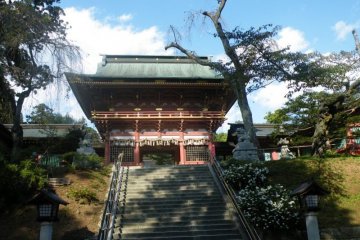

The Entsuin Temple was built next to Matsushima's main temple, the Zuiganji Temple, in 1647 to house the mausoleum of Date Mitsumune, son of the ruling local feudal lord Date Terumune. The temple was built out of mourning and is Kannon, the Buddhist goddess." Dedicated to Mercy, since Mitsumune died a sudden, premature death at the age of 19.
Far back on the temple grounds is the mausoleum, which houses a statue of the young lord on a white horse, surrounded by his most loyal followers, who committed ritual suicide after his death. The interior of the mausoleum is decorated with gold leaf and ornate paintings, which also contain Western symbols such as spades, hearts, diamonds, cross and the oldest Japanese rose image. These symbols were included in the design because the clan had an interest in Christianity and Western technology.

Seiryuzan Zuigan-ji is a Rinzai Zen Buddhist temple in located in the town of Matsushima, Miyagi Prefecture, Japan. Belonging to the Myōshin-ji-branch of Rinzai Zen, it was founded in 828 during the Heian period by Jikaku Daishi. [Wikipedia]

Shiogama Jinja is a Shinto shrine in the city of Shiogama, Miyagi Prefecture, in the Tōhoku region of northern Japan. Known from the ninth century, fifteen of its buildings have been designated Important Cultural Properties. It is the head shrine of several hundred Shiogama shrines located throughout Japan. [Wikipedia]

일요일에 나는 마쓰시마 주변에 있길래 히요시 산노 축제에 따라갔다. 나는 북소리와 성가 소리에 귀기울여 그들을 찾아 따라갔다. 센다이에서 온 제비 춤꾼들은 활기차게 춤을 추었고, 흰색 의상을 입은 많은 남자들은 휴대용 사당을 둘러싸 도심 주변을 맴돌았다. 불교 즈이간지 사찰를 축복하고 지키는 신도 (Shinto) 축제여서 특이하지만 이곳 일본에선 각 종교의 경계선이 그리 명확하지 않다. 히요시 산노 축제는 매년 4월 셋째 주 일요일에 열린다.